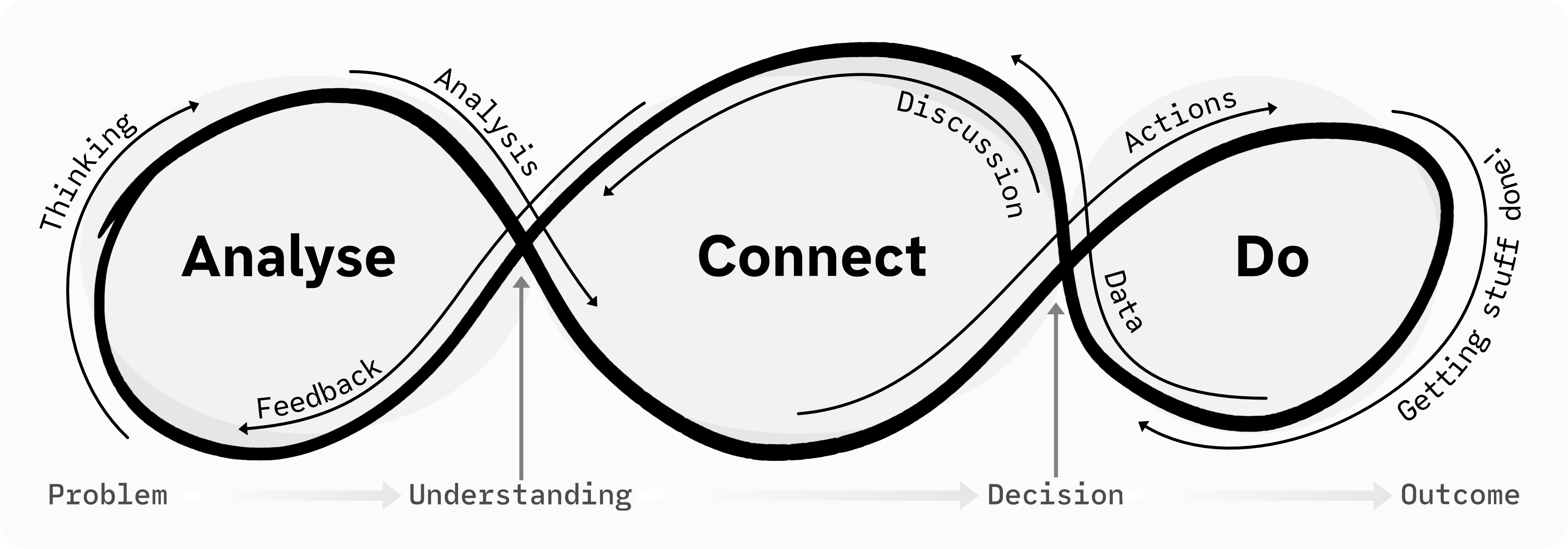The Map
Getting from idea to outcome isn’t exactly straightforward.
Every organisation works differently — how things happen in your org will be different from how they work in mine — and real progress rarely follows a neat process.
But there’s a pattern to how work — and information — moves. Whether you’re launching a product, solving a problem, or driving change, success depends on three things: analysis to understand what’s needed, connection to align people and decisions, and action to make it real.
That’s why we created The Map. It is a mental model for how work flows between these focus areas — from idea to outcome.

Analyse, Connect, Do
The map has three focus areas — Analyse, Connect, and Do.
Analyse
All good outcomes start here. To analyse — to really examine and understand something — is the fundamental value-add of any Outcomes Engineer. Many of the Jimmy Tools focus on analysis for this reason.
Connect
The ability to share understanding and put that knowledge to use is the sign of a good Outcomes Engineer. And connecting is how we do this. Connecting puts people — our stakeholders, clients, team members, and customers — at the heart of outcomes engineering.
At it’s most powerful, outcomes engineering is a special kind of facilitation that leverages the deep knowledge that you have built of the problem space to enable truly informed decision-making by organisations and teams.
Do
But neither shared understanding, nor a clear pathway forward, is anyone’s true end goal. Outcomes only happen as a result of action. You simply aren’t an Outcomes Engineer if you aren’t getting stuff done.
Implementing solutions is the ultimate test — until you get here it is all theory and discussion. Doing requires us to focus continuously on what’s important and to operate in the details while maintaining connection between the minutiae and the objectives.
You need all three to create value
- Without Analyse, we’re working blind: no understanding of root causes or real impacts.
- Without Connect, we’re working in silos: no shared understanding or aligned decisions.
- Without Do, we’re just talking: no value delivered, no real progress made.
How work moves
The map is loopy and iterative. The reason for this isn’t merely aesthetic. The loopiness (that’s a word right?) acknowledges that making progress is rarely linear and simple.
Just because your Analysis work builds understanding does not mean that you’re ready to make a decision. It is far more likely that the feedback you receive during socialisation (Connect) will push you back into Analysis before being able to support a clear direction for action (Do).
The rules
All great things have rules (potentially extremely unpopular Jimmy opinion right there 👀) and this map has three:
First, agreement is required before any action is taken You are not permitted to take action without agreement (or at the very least, endorsement). This rule helps to ensure that the right conversations have taken place before committing to a path.
Secondly, move things to done as soon as practicable. The aim of the game is not to keep things moving ’round and ’round the model. The aim is to close things out. This means focusing on what can be completed rather than on starting new things.
In other words: understanding is vital, but not at the cost of shipping value.
And third, meet the exit conditions. The map separates action from analysis and deliberately puts connection front and centre. No matter which focus area you are in, there is an exit that you are chasing: a condition that must be met before moving on.
- For Analyse, the exit condition is understanding
- For Connect, the exit condition is a decision (or enough feedback to frame up the next piece of Analysis work)
- For Do, the exit is getting stuff done (or gathering real-world data to share)
Yeah so what?
The Map is the most conceptual element of the whole Jimmy approach and it underpins everything we do. While you can use the tools and the methods without the Map, the greatest value will come from using them all together.